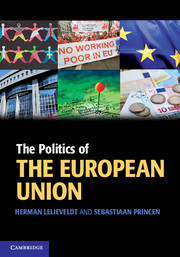Book contents
- Frontmatter
- Contents
- Acknowledgements
- List of briefings
- List of fact files
- List of controversies
- List of tables
- List of figures
- List of abbreviations and acronyms
- List of country abbreviations used in tables and figures
- Preface
- PART I Setting the scene: origins, analytical perspectives and institutions
- 1 The historical development of the EU
- 2 Analysing the EU
- 3 The institutional framework
- 4 Legislation and decision-making: putting the institutional puzzle together
- PART II Key actors in EU politics: citizens, interest groups and political parties
- Part III EU policies: agenda-setting, decision-making and implementation
- Conclusions and reflections
- Key terms and concepts
- Index
3 - The institutional framework
from PART I - Setting the scene: origins, analytical perspectives and institutions
- Frontmatter
- Contents
- Acknowledgements
- List of briefings
- List of fact files
- List of controversies
- List of tables
- List of figures
- List of abbreviations and acronyms
- List of country abbreviations used in tables and figures
- Preface
- PART I Setting the scene: origins, analytical perspectives and institutions
- 1 The historical development of the EU
- 2 Analysing the EU
- 3 The institutional framework
- 4 Legislation and decision-making: putting the institutional puzzle together
- PART II Key actors in EU politics: citizens, interest groups and political parties
- Part III EU policies: agenda-setting, decision-making and implementation
- Conclusions and reflections
- Key terms and concepts
- Index
Summary
Introduction
For a long time many observers have lamented the lack of a clear personification of the EU. Take, for example, the European Council – the institution that brings together the Heads of State and Government of the member states. It traditionally made use of a rotating chairman, which came from the member state that happened to hold the Presidency of the EU, a responsibility which lasts for only six months before it is handed over to the next member state in line. Because this chairman was the face of the EU when it comes to meeting heads of state of other countries, someone like the president of the USA would have to deal with no less than eight different EU ‘Presidents’ during his or her four years in office. This arrangement was neatly characterized by Commission President Barroso who once remarked that even soccer clubs change coaches less frequently.
The Lisbon Treaty tackled this problem by creating a somewhat more permanent post of President of the European Council, which would be appointed by the European Council itself and chair its meetings for a renewable term of two and a half years. This new position would not only facilitate more lasting relations with other countries, but also ensure more continuity in the work of the European Council.
- Type
- Chapter
- Information
- The Politics of the European Union , pp. 51 - 78Publisher: Cambridge University PressPrint publication year: 2011



